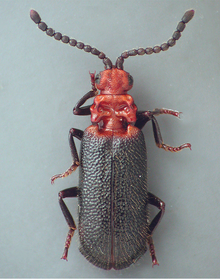Protopaussus
| Protopaussus | |
|---|---|

| |
| Protopaussus sp., collected in Thailand | |

| |
| P. feae, collected in Myanmar. | |
| Scientific classification | |
| Domain: | Eukaryota |
| Kingdom: | Animalia |
| Phylum: | Arthropoda |
| Class: | Insecta |
| Order: | Coleoptera |
| Family: | Carabidae |
| Subfamily: | Paussinae |
| Tribe: | Protopaussini |
| Genus: | Protopaussus Gestro, 1892[1] |
| Type species | |
| Protopaussus feae Gestro, 1892
| |
Protopaussus is a genus of ground beetles in the family Carabidae, the sole genus of the tribe Protopaussini. It is found in Indomalaya and temperate Asia.[2][3]
Species
These nine species belong to the genus Protopaussus:[2]
- Protopaussus almorensis Champion, 1923 (India and Nepal)
- Protopaussus bakeri Heller, 1914[4] (Philippines)
- Protopaussus feae Gestro, 1892[1] (Myanmar)
- Protopaussus javanus Wasmann, 1912[5] (Indonesia)
- Protopaussus jeanneli Luna de Carvalho, 1960[6] (Borneo, Indonesia, and Laos)
- Protopaussus kaszabi Luna de Carvalho, 1967[6] (Taiwan and temperate Asia)
- Protopaussus vignai Nagel, 2018[7] (Nepal)
- Protopaussus walkeri C.O. Waterhouse, 1897[8] (China)
- † Protopaussus pristinus Nagel, 1987[7]
References
- ^ a b Gestro, R. (1892). "Viaggio di Leonardo Fea in Birmania e regioni vicine XLVI". Annali del Museo Civico di Storia Naturale di Genova. Ser. 2. 12: 706–708.
- ^ a b "Protopaussus Gestro, 1892". Catalogue of Life. Retrieved 2023-03-19.
- ^ Lorenz, Wolfgang (2021). "Carabcat Database". doi:10.48580/dfqf-3dk. Retrieved 2023-03-04.
- ^ Heller, K. M. (1914). "Eine dritte Protopaussus-Art". Wiener entomologische Zeitung. 33 (5–6): 203–205. doi:10.5962/bhl.part.17797.
- ^ Wasmann, E. (1912). "Zwei neue Paussiden und ein neuer Rhysopaussine aus Niederländisch Indien". Tijdschrift voor Entomologie. 55 (4): 255–262.
- ^ a b Luna de Carvalho, Ed. (1967). "Études Paussidologiques (Coleoptera Carab. Paussinae)" (PDF 23.8 MB). Annales historico-naturales Musei nationalis hungarici. Pars Zoologica. 59: 259–274.
- ^ a b Nagel, Peter (1997). "New fossil paussids from Dominican amber with notes on the phylogenetic systematics of the paussine complex (Coleoptera: Carabidae)". Systematic Entomology. 22 (4): 345–362. doi:10.1046/j.1365-3113.1997.d01-51.x. S2CID 84564101.
- ^ Waterhouse, Charles O. (1897). "Description of a new Coleopterous Insect of the family Paussidæ". Transactions of the Royal Entomological Society of London. 1897 (4): 391–392. doi:10.1111/j.1365-2311.1897.tb00977.x.
